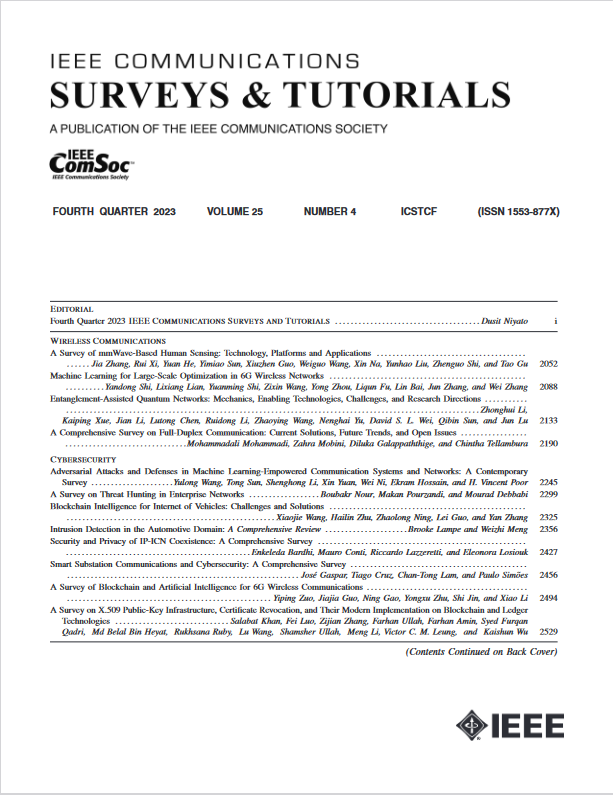物联网的后量子区块链安全:调查与研究方向
IF 34.4
1区 计算机科学
Q1 COMPUTER SCIENCE, INFORMATION SYSTEMS
引用次数: 0
摘要
区块链在商业和学术界越来越受欢迎,因为它可以为广泛的应用提供安全性。因此,研究人员一直在积极利用区块链的特性,如数据不变性、透明度和抵御物联网(IoT)中单点故障的能力,以提高物联网生态系统的安全性。然而,现有的许多区块链都依赖于经典密码系统,如椭圆曲线数字签名算法(ECDSA)和 SHA-256 来验证交易,而在可预见的未来,这些系统将被运行在量子计算机上的 Shor 和 Grover 算法所破坏。后量子密码系统(PQC)是一种抵御量子攻击的创新解决方案,可应用于区块链,从而创建一种新型区块链,即后量子区块链(PQB)。在本调查中,我们将研究不同类型的 PQC 及其最新标准基元,以确定它们是否能确保基于区块链的物联网应用的安全性。它还简要介绍了区块链,并概述了最近的区块链物联网应用提案。据我们所知,这是第一项研究如何开发后量子区块链,以及如何利用它们为不同的物联网应用创建安全机制。最后,本研究探讨了将量子抗性区块链集成到物联网生态系统中所面临的主要挑战和潜在研究方向。本文章由计算机程序翻译,如有差异,请以英文原文为准。
Post-Quantum Blockchain Security for the Internet of Things: Survey and Research Directions
Blockchain is becoming increasingly popular in the business and academic communities because it can provide security for a wide range of applications. Therefore, researchers have been motivated to exploit blockchain characteristics, such as data immutability, transparency, and resistance to single-point failures in the Internet of Things (IoT), to increase the security of the IoT ecosystem. However, many existing blockchains rely on classical cryptosystems such as the Elliptic Curve Digital Signature Algorithm (ECDSA) and SHA-256 to validate transactions, which will be compromised by Shor and Grover’s algorithms running on quantum computers in the foreseeable future. Post-Quantum Cryptosystems (PQC) are an innovative solution for resisting quantum attacks that can be applied to blockchains, resulting in the creation of a new type of blockchain known as Post-Quantum Blockchains (PQB). In this survey, we will look at the different types of PQC and their recent standard primitives to determine whether they can enable security for blockchain-based IoT applications. It also briefly introduces blockchain and outlines recent blockchain-IoT application proposals. To the best of our knowledge, this is the first study to examine how post-quantum blockchains are being developed and how they can be used to create security mechanisms for different IoT applications. Finally, this study explores the main challenges and potential research directions that arise from integrating quantum-resistance blockchains into IoT ecosystems.
求助全文
通过发布文献求助,成功后即可免费获取论文全文。
去求助
来源期刊

IEEE Communications Surveys and Tutorials
COMPUTER SCIENCE, INFORMATION SYSTEMS-TELECOMMUNICATIONS
CiteScore
80.20
自引率
2.50%
发文量
84
审稿时长
6 months
期刊介绍:
IEEE Communications Surveys & Tutorials is an online journal published by the IEEE Communications Society for tutorials and surveys covering all aspects of the communications field. Telecommunications technology is progressing at a rapid pace, and the IEEE Communications Society is committed to providing researchers and other professionals the information and tools to stay abreast. IEEE Communications Surveys and Tutorials focuses on integrating and adding understanding to the existing literature on communications, putting results in context. Whether searching for in-depth information about a familiar area or an introduction into a new area, IEEE Communications Surveys & Tutorials aims to be the premier source of peer-reviewed, comprehensive tutorials and surveys, and pointers to further sources. IEEE Communications Surveys & Tutorials publishes only articles exclusively written for IEEE Communications Surveys & Tutorials and go through a rigorous review process before their publication in the quarterly issues.
A tutorial article in the IEEE Communications Surveys & Tutorials should be designed to help the reader to become familiar with and learn something specific about a chosen topic. In contrast, the term survey, as applied here, is defined to mean a survey of the literature. A survey article in IEEE Communications Surveys & Tutorials should provide a comprehensive review of developments in a selected area, covering its development from its inception to its current state and beyond, and illustrating its development through liberal citations from the literature. Both tutorials and surveys should be tutorial in nature and should be written in a style comprehensible to readers outside the specialty of the article.
 求助内容:
求助内容: 应助结果提醒方式:
应助结果提醒方式:


